
The St. Anna Platz is a square in Munich. It is registered as a listed ensemble in the Bayerische Denkmalliste (Bavarian Historical buildings list). [1]

The St. Anna Platz is a square in Munich. It is registered as a listed ensemble in the Bayerische Denkmalliste (Bavarian Historical buildings list). [1]
St.-Anna-Platz is located in the Munich district of Lehel north of Maximilianstraße. [2] It extends from St.-Anna-Straße to the east. On the east side, a short stretch of road connects the square with Triftstraße.
The square was created at the end of the 19th century within the construction of the new parish church of St. Anna. Previously, the Franciscan monastery with the Klosterkirche St. Anna im Lehel (monastery church), which had received a neo-Romanesque two-tower façade in 1852/53, stood here only in the west. [3]
The church was built from 1887 to 1892 according to plans by Gabriel von Seidl in neo-Romanesque style. [2] Approximately parallel to this, the edge of the square was built on three sides by various architects in the neo-Renaissance style.
In 1965/66 the façade of the monastery church was reconstructed in baroque style, [4] whereby the original overall impression of the square was lost.

The St.-Anna-Platz has an approximately rectangular shape with a length of about 100 m and a width of about 75 m. It is slightly widened towards St.-Anna-Straße.
In the middle of the square, the neo-Romanesque parish church stands elevated on a terrace surrounded by a low enclosure wall. Opposite it on the other side of St.-Anna's-Straße is the Franciscan monastery with the baroque façade of the monastery church. Part of the northern side of the square is occupied by the southern wing of St.-Anna's-Grammar School. [3]
The square has been rebuilt on three sides, only the west side on St.-Anna-Straße is exposed. The row of houses on the south side (No. 1, 1a, 2, 3, 4) is completely preserved, the houses are listed as historical buildings. [1] Of the remaining houses, only no. 9 in the north-east corner and the St.-Anna-Gymnasium have been preserved and are listed as historical buildings. [5] [6] In the southwest of the square is the St.-Anna-Fountain, also built by Gabriel von Seidl in 1894. [3]

In the house at St.-Anna-Platz 2, the writer Lion Feuchtwanger spent his childhood from 1889 to 1900. A commemorative plaque is attached to the house, which was created in 1966 by the sculptor Karl Oppenrieder. [7] [8]

The Franciscan Monastery of the Holy Land in America is a Franciscan complex at 14th and Quincy Streets in the Brookland neighborhood of Northeast Washington, D.C. Located on a hill called Mount Saint Sepulcher, and anchored by the Memorial Church of the Holy Sepulcher, it includes gardens, replicas of various shrines throughout Israel, a replica of the catacombs in Rome, an archive, a library, as well as bones of Saint Benignus of Armagh, brought from the Roman catacombs and originally in the cathedral of Narni, Italy.
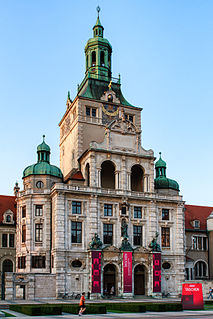
The Bavarian National Museum in Munich is one of the most important museums of decorative arts in Europe and one of the largest art museums in Germany. Since the beginning the collection has been divided into two main groups: the art historical collection and the folklore collection.
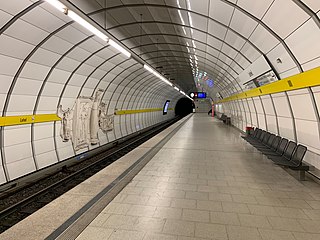
Lehel is a Munich U-Bahn station located centrally in the Lehel quarter of Munich. It is on the U4 and U5 lines between Odeonsplatz to the west and Max-Weber-Platz to the east, and is also served at ground level by tram line 18.

Markt Indersdorf is a municipality in the district of Dachau in Bavaria in Germany.

Altstadt and Lehel are districts of the German city of Munich. Together they form the first borough of the city: Altstadt-Lehel.

This article is intended to give an overview about the architecture of Munich, Germany.

Haidhausen is a quarter of Munich, Germany. It is now part of the borough—or stadtbezirk—number 5 Au-Haidhausen.
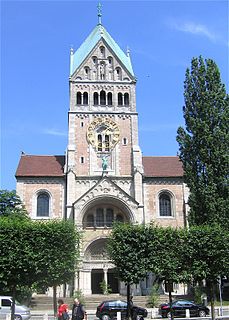
St. Anna im Lehel is a parish of the Roman Catholic Church in the Lehel district of Munich. Founded in 1808, it is staffed by Franciscans from the adjacent abbey of St. Anna.
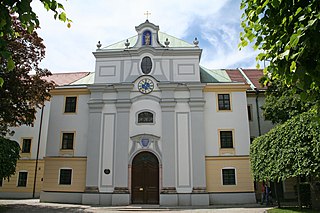
Klosterkirche St. Anna im Lehel is a Catholic abbey church in Munich, Germany. It was the first Rococo church of Old Bavaria and shaped the development of religious architecture in Bavaria. It is located in the center of Lehel opposite to the neo-romanesque Catholic parish church of St. Anna im Lehel.
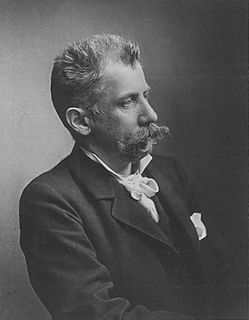
Gabriel von Seidl was a German architect and a representative of the historicist style of architecture.

The Königinstraße is a street in Munich. It runs west of the Englischer Garten from the Von-der-Tann-Straße in the district of Maxvorstadt, to the north and to the Maria-Josepha-Straße and Mandlstraße in the Ensemble Alt-Schwabing.

Neuhauser Straße is part of the first and largest pedestrian zone in Munich's Old Town. Here, many retail shops and restaurants are to be found.

Angertorstraße 3 is an apartment building in Munich, Germany that is a registered Bavarian historical monument.

Denning is a district of the Bavarian capital Munich that belongs to district 13 Bogenhausen.

The Munich Old Town is part of the Bavarian capital Munich and has belonged to the city the longest, even if some places which are meanwhile districts of Munich, were mentioned long before Munich's documents spoke of the Old Town. The Old Town forms together with the district Lehel, the municipality No. 1 Altstadt-Lehel. The entire area of the Old Town is listed as both a historical ensemble as well as a historical monument listed in the Bavarian historical monument list.

The Ismaninger Straße is a city center, entrance and exit road in Munich.

The Gollierplatz is a square in Munich's Westend district.

Alter St.-Georgs-Platz is a square in Munich's Milbertshofen-Am Hart district.

Gabelsbergerstraße is a city centre street in the Munich district of Maxvorstadt. It leads from Oskar-von-Miller-Ring in a north-western direction to Dachauer Straße, where it becomes Josef-Ruederer-Straße. Over its entire length it is a one-way street with the direction of travel from west to east.